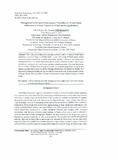| dc.contributor.author | Aura, J. | |
| dc.contributor.author | Waturu, C.N. | |
| dc.contributor.author | Kasina, M.J. | |
| dc.contributor.author | Nderitu, J H. | |
| dc.contributor.author | Nyamasyo, G. N. | |
| dc.date.accessioned | 2013-06-19T12:10:08Z | |
| dc.date.available | 2013-06-19T12:10:08Z | |
| dc.date.issued | 2008 | |
| dc.identifier.citation | Journal of Entomology 5 (3): 148-155, | en |
| dc.identifier.issn | 1812-5670 | |
| dc.identifier.uri | http://erepository.uonbi.ac.ke:8080/xmlui/handle/123456789/36228 | |
| dc.description.abstract | TIlls study was conducted to measure economic benefit of using different spray
schedules to control thrips on French beans. It was done using different spray regime
scenarios of two insecticides: Lambda cyhalothrin (Karate 1.75% EC) and Methiocarb
(Mesurol 500 SC). It is shown that increasing the number of sprays results to lower thrips
infestations, explaining why local farmers practice calendar spraying. However, this lowers
the net returns obtained from French bean sales. In contrast, application of one to two
sprays maintains thrips below economic damage and provides the highest net returns. It is
suggested that farmers should only use the effective insecticide after noting a density of three
thrips per flower. TIlls is possible if farmers embrace monitoring of thrips buildup on French
beans. | en |
| dc.language.iso | en | en |
| dc.publisher | Academic Journals Inc. | en |
| dc.subject | Action threshold, economic damage, economic injury level, economic returns, | en |
| dc.title | Management of Thrips (Thysanoptera: Thr ipidae) on French Beans (Fabaceae) ir Kenya: Economics of Insecticide Applications | en |
| dc.type | Article | en |
| local.publisher | Department of Plant Science and Crop Protection, University of Nairobi, | en |
| local.publisher | 2Centre for Development Research (ZEF), University of Bonn, Postfasch: Walter-Flex-Str.3, 53113 Bonn, Germany | en |
| local.publisher | Department of Zoology, University of Nairobi | en |


